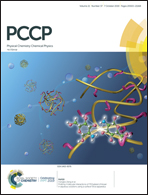How does the mutation in the cap domain of methylcobalamin-dependent methionine synthase influence the photoactivation of the Co–C bond?†
Abstract
Methionine synthase (MetH) is a methylcobalamin (MeCbl)-dependent mammalian enzyme which plays a critical role in carrying out the transfer of a methyl group from methyl tetrahydrofolate to homocysteine to generate methionine and tetrahydrofolate. This catalytic cycle proceeds via cleavage of a Co–C bond which is formally heterolytic. This cleavage results in a structural change in the MeCbl cofactor bound to an enzyme. Unlike the native catalysis, upon photoexcitation, the Co–C bond in MeCbl-bound MetH generates the Co(II)/CH3 radical pairs (RPs). Protein residues of the cap domain, particularly phenylalanine708 (F708) and leucine 715 (L715), which surrounds the upper face of the MeCbl cofactor, inhibit the photolysis of MeCbl by caging the CH3 radical and inducing the geminate recombination of the Co(II)/CH3 RP. A molecular-level understanding of these effects requires a detailed investigation of the low-lying electronic states. Toward this, we have mutated the F708 residue with alanine (A708) and constructed the potential energy surfaces (PESs) for the low-lying S1 electronic state using a combined quantum mechanics/molecular mechanics (QM/MM) approach. The S1 PESs for the wild-type (WT) and mutant enzymes are the result of crossing of two electronic states, namely metal-to-ligand charge transfer (MLCT) and ligand field (LF) states, indicated by a seam. It is shown that the topologies of the S1 PESs are significantly modulated by introducing a mutation at the F708 position. Specifically, for the WT enzyme, the energy barrier of photoreaction and the energy difference between MLCT and LF minima are markedly higher than those of its mutant counterpart. Moreover, mutation influences the photoactivation of the Co–C bond in enzyme-bound MeCbl by decreasing the rate of geminate recombination and altering the rate of radical pair formation. This theoretical insight was also compared with transient absorption spectroscopic (TAS) studies which are in good agreement with the present findings.



 Please wait while we load your content...
Please wait while we load your content...